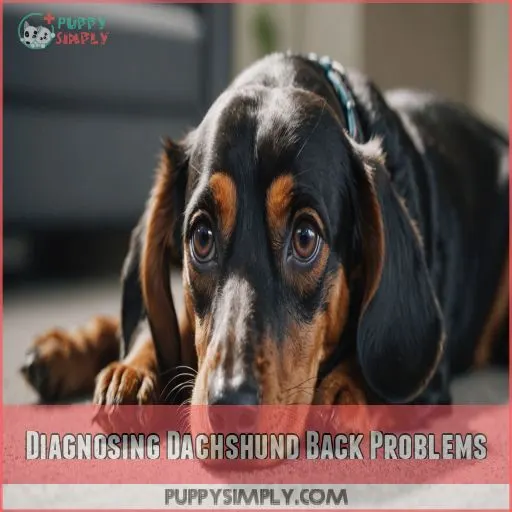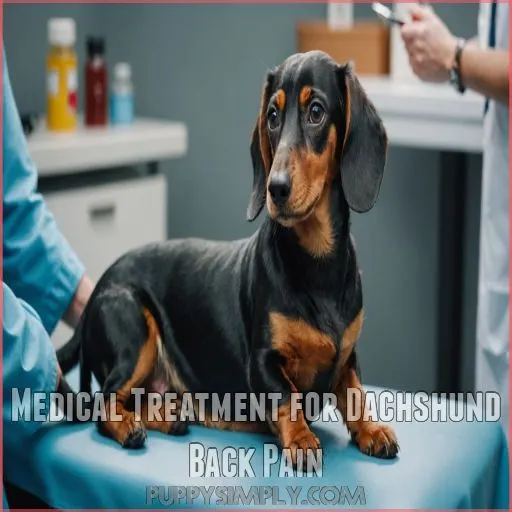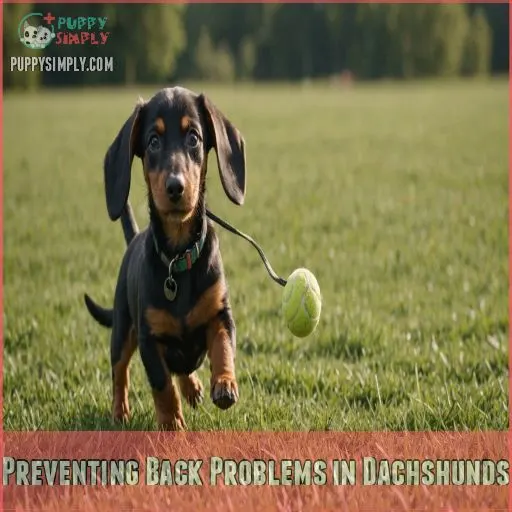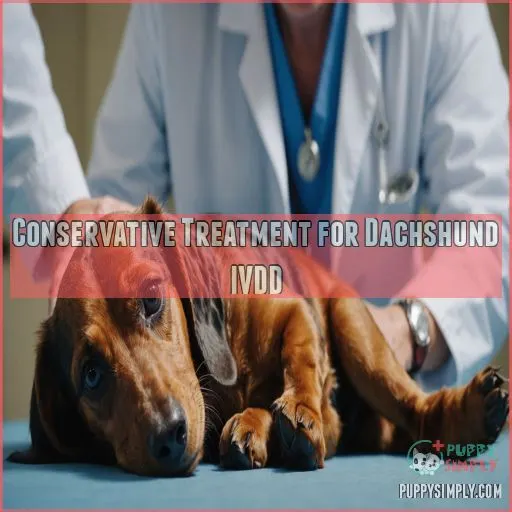This site is supported by our readers. We may earn a commission, at no cost to you, if you purchase through links.
 Dachshund back problems treatment isn’t a walk in the park, but don’t worry – you’ve got options.
Dachshund back problems treatment isn’t a walk in the park, but don’t worry – you’ve got options.
First up, give your sausage dog some R&R with crate rest. Your vet might prescribe anti-inflammatory meds like Carprofen to ease the pain.
Physical therapy can work wonders, helping your pup build back strength.
In severe cases, surgery might be on the table to remove damaged discs.
Remember, prevention is key – keep your dachshund at a healthy weight and use a harness instead of a collar.
With the right care, your little hotdog can bounce back from back troubles, and physical therapy can be a crucial part of that. But wait, there’s more to keeping your dachshund’s spine in line… it all starts with crate rest.
Table Of Contents
- Key Takeaways
- Diagnosing Dachshund Back Problems
- Medical Treatment for Dachshund Back Pain
- Surgical Options for Dachshund Back Issues
- Managing Chronic Back Pain in Dachshunds
- Preventing Back Problems in Dachshunds
- Dachshund IVDD Recovery and Rehabilitation
- Herniated Discs in Dachshunds
- Conservative Treatment for Dachshund IVDD
- Strengthening Your Dachshund’s Back at Home
- Long-Term Care and Monitoring for Dachshunds
- Frequently Asked Questions (FAQs)
- How do you treat a dachshund’s back pain?
- Do Dachshunds have back problems?
- Can dachshund spine problems be treated without surgery?
- What are my dachshund’s surgical options?
- What to do when a dachshund hurts their back?
- What medication is used for dachshund back pain?
- How to strengthen dachshund back at home?
- Can a dachshund recover from IVDD?
- How long does recovery from Dachshund back surgery take?
- Can acupuncture help with Dachshund back problems?
- Are certain Dachshund coat types more prone to back issues?
- Whats the success rate of back surgery for Dachshunds?
- How do water therapy exercises benefit Dachshunds with back problems?
- Conclusion
Key Takeaways
- You’re not barking up the wrong tree with crate rest – it’s your dachshund’s cozy healing cocoon for 2-8 weeks after an IVDD diagnosis. Think of it as pressing pause on squirrel-chasing to focus on recovery.
- Don’t let your wiener dog become a chunky monkey – maintaining a healthy weight is crucial for preventing back problems, especially when considering an ideal weight range
. Aim for a trim figure between 16 and 32 pounds for standard dachshunds, or under 11 pounds for minis.
- Ditch the collar and embrace the harness – it’s like finding the perfect dance partner for your dachshund’s spine. Look for one with even weight distribution and adjustable straps for a custom fit.
- Keep your vet on speed dial – regular check-ups are like tune-ups for your furry friend’s spine. They’ll help you nip potential issues in the bud and keep that precious backbone in tip-top shape.
Diagnosing Dachshund Back Problems
You should keep an eye out for common signs of back issues in your Dachshund, such as wobbliness or reluctance to move, as these may indicate spinal problems.
Diagnosing these conditions involves a veterinary exam, neurological tests, and imaging studies like x-rays or MRIs to pinpoint the issue with precision, which is crucial for an accurate diagnosis and effective treatment plan, especially when dealing with neurological tests.
Common Symptoms of Back Issues
Spotting symptoms of dachshund spine problems can be a guessing game, but they often include these signs:
- Back pain: Your dog may stand with a hunched back or show reluctance to walk.
- Muscle spasms: Notice any twitching or tension?
- Loss of bladder control: This could point to intervertebral disc disease or a slipped disc.
Evaluating Spinal Damage
One key way to evaluate spinal damage in your Dachshund is through a thorough neurological exam.
Your vet will check for deep pain response, toe pinch, and tail pinch reflexes to gauge nerve function. They may also assess spinal reflexes to identify any issues with the vertebrae or discs.
Prompt diagnosis is essential for effective treatment.
Imaging Studies for Diagnosis
Surfing the wave of technology, imaging studies are important for diagnosing dachshund back problems. X-rays help interpret bone issues, though EKG might miss soft tissue damage, leading to false negatives.
For a more vivid picture, consider MRI or CT, weighing imaging costs. Myelography can clarify certain cases, especially when looking at conditions like Intervertebral Disk Disease.
As dachshund owners know, preventing strenuous exercise, obesity, and overfeeding keeps those long backs healthy. Managing dachshund weight is key, so remember to keep those long backs healthy! (Source).
Identifying Spinal Infections
Let’s move into identifying spinal infections in dachshunds, where symptoms can mimic other back issues. Spinal fluid analysis helps pinpoint infections, but diagnosis challenges persist.
- Increased pain despite treatment
- Fever and lethargy
- Poor response to usual calming remedies
- Changes in behavior during crate rest
Addressing these with antibiotics can have a major impact on treatment duration.
Medical Treatment for Dachshund Back Pain
When your dachshund’s back is causing pain and misery, medical treatment focuses on managing discomfort with NSAID pain relief, steroids, and muscle relaxants to reduce inflammation
.
Proper weight control plays a key role in supporting your furry friend’s spinal health. Along with antibiotics for any suspected spinal infections, it is essential for overall spinal well-being, which is often achieved through proper weight control.
Pain Reduction and Inflammation Management
After diagnosing your dachshund’s back issues, it’s time to tackle the pain head-on.
Your vet might prescribe NSAIDs to reduce inflammation and ease discomfort.
For a more holistic approach, consider cold laser therapy or the Assisi loop to promote healing (Source).
Don’t forget natural remedies like VetriScience Composure to keep your pup calm during recovery.
Remember, a pain-free pooch is a happy pooch!
Muscle Relaxants and Steroids
Muscle relaxants and steroids can be a double-edged sword in treating your dachshund’s back pain. While they offer relief, it’s essential to use them wisely.
Your vet might prescribe methocarbamol to ease muscle spasms, but steroids are now less favored due to potential side effects.
Consider these options:
- A cozy recovery suite with a supportive bed
- Gentle dachshund swimming for low-impact exercise
- A specialized dachshund diet to maintain a healthy weight
- Alternative treatments like acupuncture or laser therapy
Antibiotics for Spinal Infections
Spinal infection-busters, antibiotics play a key role in your dachshund’s back health.
Your vet may prescribe broad-spectrum antibiotics like cephalosporins or fluoroquinolones to combat bacterial invaders. Treatment typically lasts 6-8 weeks.
While your furry friend recovers, consider using a dog stroller for gentle outings. Remember, antibiotics can have side effects, so monitor your pup closely.
Alternative therapies like the Assisi loop or hemp CBD may complement traditional treatments, but always consult your vet first.
Weight Management for Back Health
Keeping your dachshund at an ideal weight is like giving their back a superhero cape. Even a tiny bit of extra weight can put a big strain on those adorable long spines.
To help your wiener dog stay trim and healthy, focus on high protein puppy food that’s rich in nutrients and low in calories. You can also consider foods with fiber-rich ingredients like beets or pumpkin to promote a feeling of fullness and support healthy digestion.
- Consult your vet for personalized diet tips
- Choose low-calorie treats and healthy food options
- Implement a gentle exercise regime that doesn’t strain the back
Remember, a svelte dachshund is a happy dachshund!
Surgical Options for Dachshund Back Issues
If your dachshund’s back problems don’t respond to medical treatment, surgery may be necessary.
Your vet will discuss options like disc removal or spinal stabilization, weighing the potential benefits against the recovery time and risks.
Types of Surgery for IVDD
Understanding IVDD surgery can feel like a maze, but don’t worry – we’ll break it down for you.
The two main types are fenestration and hemilaminectomy . Fenestration’s quicker and simpler, removing disc material through a small window.
Hemilaminectomy’s more complex, drilling a hole to remove extruded material.
Your vet will recommend the best option based on your dachshund’s condition, weighing factors like surgical risks, post-op care, and cost comparison .
Spinal Trauma and Emergency Surgery
When your dachshund faces a spinal emergency, time is of the essence. Quick trauma diagnosis can make all the difference.
If your furry friend shows signs like shivering, yelping when touched, or dragging their back legs, don’t wait – head to the vet immediately.
Emergency surgery might be necessary to remove bone or disc material pressing on the spinal cord. Your quick action could be the key to your pup’s recovery.
Risks and Recovery From Surgery
After emergency surgery, you’ll face new challenges. Your dachshund’s recovery timeline varies, but most dogs walk within 2-8 weeks.
Watch for post-op complications like infection or pain. You’ll need to manage pain, start physical therapy, and make lifestyle adjustments. It’s like teaching your pup to walk a tightrope – slow and steady wins the race.
Additionally, it’s essential to monitor their condition closely, as dachshunds are prone to back issues. Maintaining a healthy weight through a balanced diet and regular exercise can also help alleviate strain on their spine. Remember, patience is key in this healing journey.
Managing Chronic Back Pain in Dachshunds
If you’re dealing with a Dachshund’s chronic back pain, you’ll need a well-rounded approach to manage their discomfort and improve their quality of life.
You can support your sausage dog’s spinal health through physical therapy.
Using anti-slip stairs and back supports can also be beneficial.
Making key lifestyle adjustments specific to their needs is crucial for managing their condition and providing the necessary care and comfort for your Dachshund, which can be achieved through a well-rounded approach.
Physical Therapy for Back Strength
Physical therapy can be a game-changer for your dachshund’s back health.
It’s like giving your pup’s spine a personal trainer. Start with gentle exercises to build strength and improve balance.
Try the ‘sit to stand‘ routine, backing your dog into a corner and encouraging them to stand and sit repeatedly.
Slow and steady wins the race – focus on proper form over speed to avoid any setbacks.
Anti-Slip Stairs and Back Support
Your dachshund’s back health isn’t just about exercise—it’s also about their environment. Anti-slip stairs and back support can be game-changers for your sausage dog’s spine. Think of these tools as your pup’s personal bodyguards, always on duty to prevent slips and support that long, adorable back.
Here are some DIY solutions and alternative supports to check out:
- Carpet treads on stairs for extra grip
- Ramps for accessing furniture safely
- Orthopedic dog beds for proper spine alignment
- Custom-fitted back brace for daily activities
Lifestyle Changes for Spinal Health
Lifestyle tweaks can work wonders for your dachshund’s spinal health.
Start by fine-tuning their exercise routine – think short, gentle walks instead of marathon sessions.
Keep an eye on their waistline; a trim pup is a happy pup.
Swap that collar for a supportive harness to take pressure off their back.
Consider upgrading their sleep surface to something comfy yet firm.
Remember, moderation is key with regard to activity level.
Preventing Back Problems in Dachshunds
You can take proactive steps to protect your dachshund’s spine and prevent back problems.
By maintaining a healthy weight, choosing the right harness, and avoiding high-impact activities, you’ll help prevent strain on your dachshund’s back.
Considering therapies like pulsed electromagnetic field treatment can also help keep your wiener dog’s back in tip-top shape.
Maintaining a Healthy Weight
Maintaining a trim figure is key to your Dachshund’s back health.
Excess pounds can strain their elongated spine, increasing the risk of intervertebral disc disease (IVDD) .
Aim for a weight between 16-32 pounds for standard Dachshunds, or under 11 pounds for minis.
To achieve this, monitor their diet, measure portions, and opt for healthy snacks like carrots.
Regular exercise, such as short walks or swimming, will help keep your wiener dog’s waistline—and spine—in tip-top shape.
Choosing the Right Harness
Choosing the right harness for your dachshund is like finding the perfect dance partner – it’s all about compatibility and comfort. A well-fitted harness can be a game-changer in preventing back problems.
Let’s waltz through some key points to keep in mind:
- Look for harnesses with even weight distribution
- Opt for designs that minimize pressure on the spine
- Make sure it fits snugly without restricting movement
- Consider padded options for extra comfort
- Choose harnesses with adjustable straps for a custom fit
Avoiding High-Impact Activities
While your dachshund might dream of being a high-flying acrobat, it’s best to keep their paws firmly on the ground.
Opt for safe play and gentle exercise to protect their delicate spines. Replace rough-housing and tug-of-war with low-impact games that won’t strain their backs.
Swimming is a fantastic alternative activity, providing a full-body workout without the stress.
Remember, your wiener dog’s health is no small matter – keep it low and slow for a happy, healthy pup.
Pulsed Electromagnetic Field Therapy
Pulsed Electromagnetic Field (PEMF) therapy offers a gentle way to support your dachshund’s back health. This non-invasive treatment uses electromagnetic waves to promote healing and reduce pain. It’s particularly useful for conditions such as arthritis, which is a common cause of hind leg collapse in dogs, often resulting in difficulty rising and abnormal gait.
Additionally, PEMF therapy can help alleviate signs of pain like increased panting or lethargy. PEMF therapy benefits include improved circulation, reduced inflammation, and enhanced cell regeneration.
While PEMF therapy devices can be pricey, many pet parents find the investment worthwhile. Research shows promising results for managing conditions like osteoarthritis in dogs.
Dachshund IVDD Recovery and Rehabilitation
You’re about to start an important journey to help your Dachshund recover from IVDD.
With proper care, including crate rest, pain management, and gentle rehabilitation, you’ll give your furry friend the best chance at regaining mobility and comfort.
This journey is crucial for your Dachshund’s recovery and well-being.
Crate Rest and Immobilization
After your dachshund’s IVDD diagnosis, crate rest becomes your new best friend. Think of it as a cozy healing cocoon for your pup.
You’ll need to keep your furry friend confined for 2-8 weeks. Choose a crate that’s just big enough for your dog to stand up and turn around.
This ‘timeout’ is essential for preventing reinjury and promoting spinal healing (Source). It’s like pressing pause on your pup’s usual squirrel-chasing antics to focus on recovery.
Pain Management and Medication
Now that your dachshund’s on crate rest, let’s talk pain management. Your furry friend’s comfort is key to recovery.
Vets often prescribe NSAIDs for pain relief and to reduce inflammation. But remember, every dog is different when it comes to medication.
Here’s a quick rundown of common options:
- NSAIDs like carprofen or meloxicam
- Gabapentin for nerve-related pain
- Opioids for severe discomfort
Always discuss potential side effects with your vet. They’ll tailor a plan that keeps your pup’s tail wagging, even during recovery.
Natural Calming Remedies and Alternatives
Calm-inducing remedies can be a game-changer for your dachshund’s IVDD recovery. CBD oil may help reduce anxiety and inflammation, while herbal teas like chamomile can soothe nerves.
Try playing soft, calming music or using pheromone diffusers to create a relaxing atmosphere.
Pressure wraps, like the ThunderShirt, can provide a comforting hug-like sensation.
Remember, a stress-free environment is essential for healing, so experiment to find what works best for your furry friend.
Using Dog Strollers for Recovery
Dog strollers can be a game-changer for your recovering dachshund. They provide a safe way to get your furry friend out and about without risking further injury.
Choose a stroller with:
- Shock absorbers for a smooth ride
- A low-lying frame for easy access
- A safety clip to secure your pup
You’ll see your dachshund’s tail wagging in no time as they enjoy the sights and smells of the outdoors, all while staying safe and comfortable during recovery.
Herniated Discs in Dachshunds
If you’ve noticed your Dachshund wincing or struggling to move, they might be dealing with a herniated disc.
These painful spinal issues are common in Dachshunds due to their unique body shape, but don’t worry – with proper care and treatment.
Your wiener dog can get back to their playful self.
Causes and Risk Factors for IVDD
Genetics play a significant role in your Dachshund’s risk for IVDD. Your furry friend’s unique body shape, with its long back and short legs, makes it more susceptible to disc issues.
As your pup ages, the risk increases. Lifestyle factors like obesity and over-exercise can also contribute.
Keep your wiener dog fit, not fat, and adopt a balanced exercise routine and healthy eating habits with a focus on Dog Obesity Prevention to help protect their spine
.
Types of Herniated Discs
When you delve into the subject of herniated discs, you’ll find two main types affecting your dachshund’s spine. Hansen Type I and Type II discs present unique challenges, each with its own quirks.
Imagine your pup’s spine as a series of tiny shock absorbers:
- Disc extrusion: Like a jelly doughnut bursting
- Disc prolapse: A slow bulge, like a balloon inflating
- Disc rupture: Sudden, forceful impact causing damage
- Disc severity: Ranging from mild discomfort to paralysis
Understanding these types helps you navigate your dachshund’s back health journey.
Symptoms and Diagnosis of Herniated Discs
A telltale sign of trouble lurks in your dachshund’s posture. Watch for an arched back or lowered head, as these could indicate disc herniation.
Your furry friend might also show reluctance to move, shiver, or yelp when touched.
In more severe cases, you’ll notice weakness in their legs, or difficulty walking. If you spot these signs, don’t wait – prompt veterinary attention is essential for proper IVDD diagnosis and treatment.
Conservative Treatment for Dachshund IVDD
If your Dachshund has been diagnosed with IVDD, you’ll be relieved to know that conservative treatment can often be effective.
This approach combines medication, physical therapy, and lifestyle changes to manage pain and promote healing, giving your furry friend a chance to recover without surgery, through conservative treatment.
Medication and Physical Therapy
Tackling IVDD head-on, you’ll find a powerful duo in medication and physical therapy.
Your vet may prescribe NSAIDs, opioids, or gabapentin to manage pain and inflammation.
Meanwhile, physical therapy exercises like standing practice can help your furry friend regain mobility.
Remember, recovery’s a marathon, not a sprint.
With patience and the right treatment cocktail, you’ll have your wiener dog wagging again in no time.
Lifestyle Changes and Weight Management
Three key lifestyle changes can greatly improve your dachshund’s back health.
Let’s dig into these paw-some tips:
- Watch that waistline: A balanced diet and portion control keep your pup fit as a fiddle.
- Exercise wisely: Opt for low-impact activities like swimming or gentle walks.
- Harness the power of support: Use a well-fitted harness to reduce strain on your dachshund’s spine.
Remember, these changes aren’t just a walk in the park—they’re a lifeline for your furry friend’s spine!
Alternative Therapies for Back Pain
Holistic approaches can offer your dachshund relief from back pain.
You might consider acupuncture, which can quickly ease discomfort and promote healing. Laser therapy is another option, using light to reduce inflammation and speed up recovery.
Chiropractic care, massage therapy, and herbal remedies may also provide benefits.
Always consult your vet before trying alternative therapies, as they’ll help tailor a treatment plan that’s just right for your furry friend.
Strengthening Your Dachshund’s Back at Home
You can strengthen your dachshund’s back at home with targeted exercises and supportive tools.
By incorporating gentle physical therapy and using back support devices, you’ll help your wiener dog maintain a healthy spine.
You’ll also reduce the risk of future problems, helping your dog to live a long and healthy life with a strong healthy spine.
Exercise and Physical Therapy
Now that you’ve got a handle on conservative treatment, let’s focus on strengthening your dachshund’s back at home.
Physical therapy exercises can work wonders for your wiener dog’s spine health. You’ll be amazed at how these simple activities can help your furry friend bounce back:
Incorporating puppy exercise basics, such as playtime and obedience training tips, into your physical therapy routine can be incredibly beneficial for your dachshund’s overall health.
Regular exercise also helps to build muscle, which is essential for supporting their back.
- Gently guiding your dachshund through sit-to-stand exercises, like a tiny canine gym session
- Encouraging side-to-side stretches, as if your pup’s nose is chasing an imaginary treat
- Introducing wobble board balancing, turning your living room into a circus act for core strength
Back Support and Anti-Slip Stairs
Your dachshund’s back is like a suspension bridge – it needs proper support.
Install anti-slip stairs or ramps to prevent dangerous jumps. For DIY enthusiasts, create a supportive harness using soft fabric.
These tools offer stair safety and boost your pup’s confidence.
Remember, a well-supported dachshund is a happy one. By implementing these measures, you’re not just preventing injuries; you’re giving your wiener dog the gift of mobility and independence.
Long-Term Care and Monitoring for Dachshunds
You’ll need to stay vigilant about your Dachshund’s back health long after treatment.
Regular vet check-ups and careful monitoring at home will help you catch any issues early and adjust care plans as needed, especially when considering the breed’s genetic risks
.
Ensuring your wiener dog stays happy and active for years to come requires ongoing attention to back health.
Regular Veterinary Check-Ups
While you’re strengthening your dachshund’s back at home, don’t forget the power of professional care.
Regular check-ups with your vet are like tune-ups for your furry friend’s spine.
These visits allow for early detection of potential issues, helping to nip problems in the bud.
You’ll work together on preventative care strategies and wellness plans designed to fit your pup’s needs, keeping that precious backbone in tip-top shape.
Monitoring for Spinal Issues
Vigilant monitoring is the backbone of long-term care for your dachshund’s spinal health. Keep a watchful eye on your furry friend’s movement and behavior, noting any changes that might signal spinal issues. Early detection can make all the difference in managing back problems effectively.
To stay ahead of potential issues:
- Watch for the "dachshund waddle" – a telltale sign of discomfort
- Monitor your pup’s ability to climb stairs or jump onto furniture
- Note any changes in appetite or bathroom habits
Adjusting Treatment Plans as Needed
Keep a keen eye on your dachshund’s progress and be ready to adapt their treatment plan. Like a chef tweaking a recipe, you’ll need to fine-tune your approach as your pup’s needs change.
Here’s a handy guide to help you navigate the journey:
| Situation | Action | |
|---|---|---|
| Pain increases | Review medication | |
| Mobility improves | Adjust exercise routine | |
| Weight fluctuates | Modify diet plan | |
| New symptoms appear | Consult vet immediately | |
| New symptoms appear | Consult vet immediately was replaced with, New symptoms appear | Adjust treatment plan or consult vet |
Remember, flexibility is key in managing progressive IVDD and ensuring your wiener dog’s long-term comfort.
Frequently Asked Questions (FAQs)
How do you treat a dachshund’s back pain?
Your dachshund’s back pain isn’t a walk in the park, but treatment’s within reach with the right dachshund harness support
.
Start with rest and pain meds.
If it’s serious, your vet might recommend cage confinement, weight management, or even surgery.
Don’t let your pup jump or climb stairs.
Do Dachshunds have back problems?
Dachshunds are prone to back problems due to their unique body structure.
Their long spines and short legs make them susceptible to disc herniation, which can cause pain or even paralysis.
One in five dachshunds have a gene increasing this risk.
Can dachshund spine problems be treated without surgery?
Recent studies show non-surgical treatment can be effective for dachshund spine problems.
You’ll need pain relief, comfortable rest, and customized exercise therapy.
With proper care, many dogs recover well, even those with severe symptoms. It’s like giving their back a vacation, and the key to this seems to be customized exercise therapy and rest alongside the mentioned pain relief.
What are my dachshund’s surgical options?
Studies show 90% of Dachshunds with toe sensation recover mobility after surgery.
You’ve got two main options: fenestration and hemilaminectomy. Fenestration’s quicker but doesn’t remove spinal compression, while hemilaminectomy’s more complex but fully decompresses the spinal cord.
What to do when a dachshund hurts their back?
When your furry friend hurts their back, act fast.
Keep them still and call the vet immediately.
They’ll likely prescribe rest, pain meds, and possibly cage confinement.
Don’t let them jump or use stairs while recovering.
What medication is used for dachshund back pain?
One in five Dachshunds have a gene increasing their risk of disc herniation.
You’ll find vets often prescribe NSAIDs like Previcox or opioids for back pain. Gabapentin’s another go-to, tackling nerve pain effectively.
Always consult your vet before starting any medication.
How to strengthen dachshund back at home?
To strengthen your dachshund’s back, try low-impact exercises like walking and swimming.
Incorporate balance training using cushions or wobble boards. Practice "paws up" on unstable surfaces to boost core strength.
Don’t forget sit-to-stand drills for muscle development.
Can a dachshund recover from IVDD?
Like a phoenix rising from the ashes, your dachshund can recover from IVDD.
Many dogs bounce back fully with proper care .
You’ll need patience, as recovery time varies.
Rehabilitation exercises and professional guidance boost your pup’s chances of wagging again.
How long does recovery from Dachshund back surgery take?
Recovery from dachshund back surgery varies.
Most dogs start walking within 1-3 weeks.
Full recovery can take 2-6 months.
You’ll need patience, as some pups may take longer.
Remember, every wiener dog’s journey is unique!
Can acupuncture help with Dachshund back problems?
Miraculously, acupuncture can work wonders for your dachshund’s back woes!
You’ll be amazed as those tiny needles stimulate healing, reduce inflammation, and ease pain.
It’s a safe, stress-free option that could have your pup wagging its tail in no time.
Are certain Dachshund coat types more prone to back issues?
You’ll find that coat type doesn’t determine a Dachshund’s likelihood of back issues.
All Dachshunds, regardless of their coat, are prone to IVDD due to their unique body shape.
Focus on weight management and injury prevention for your long-bodied friend.
Whats the success rate of back surgery for Dachshunds?
Back surgery for Dachshunds boasts an impressive success rate.
Studies show over 90% of dogs with grades 1-4 IVDD recover well.
However, for grade 5 cases, success drops to 50-60% if surgery occurs within 24 hours of symptoms.
How do water therapy exercises benefit Dachshunds with back problems?
Water therapy exercises provide a gentle yet effective way to strengthen your Dachshund’s back muscles.
The buoyancy reduces joint stress, while resistance builds strength.
It’s like a doggy spa day that’ll have your pooch feeling like a swimming champ!
Conclusion
Who knew a sausage-shaped pup could be such a pain in the back? But with the right dachshund back problems treatment, your furry friend can wag their tail again.
Remember, prevention is your best bet – keep them fit, use a harness, and avoid those daredevil leaps.
If trouble strikes, don’t panic. From crate rest to surgery, there’s a solution for every spine.
Stay vigilant, work closely with your vet, and give your dachshund all the TLC they need. Here’s to many more years of wiener dog wobbles, with a special emphasis on crate rest.
















